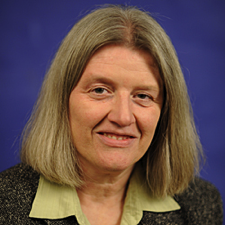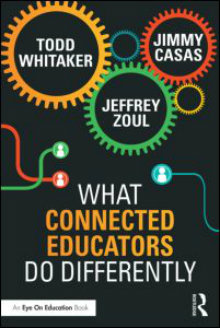How Connected Educators Use Social Media
What Connected Educators Do Differently
By Todd Whitaker, Jeffrey Zoul, and Jimmy Casas
(Routledge/Eye on Education, 2015 – Learn more)

I can’t recall the last time I immersed myself in a book as much as I did while reading What Connected Educators Do Differently by Todd Whitaker, Jimmy Casas, and Jeffrey Zoul. The book has much to offer educators in various stages of adopting social media.
Beginners can start taking action with the very first chapter if they are new to Twitter; more experienced educators will still find things to learn as the book becomes increasingly more complex in the connections it suggests. As even the authors proclaim, this book is not based on academia, as “we leaned not so much on scholarly research, but, instead, on what we ourselves were learning… There is simply too much to be gained—and nothing to lose—to not begin connecting with educators around the world.”
A primer or an enrichment tool
During the course of my teaching career, I have witnessed complete change in the ways we are able to communicate and access resources, and in the possibilities for students to learn. This book can serve as either a primer or enrichment for connectedness.
My reading of this book coincided with organizing an edCamp and participating remotely in the annual ISTE summer conference (in Philadelphia this year). I recognized more ISTE presenters and people tweeting because I had read about them in the book. I also was encouraged to resurrect my blog after reading chapter 3, so I blogged about… edCamp and ISTE. I know that applying some of the suggestions in the book deepened my experiences and learning in both cases.
How the book is structured
Each chapter of the book presents a “Key Connector” that includes some rationale and personal anecdotes and concludes with three different types of actions. The “Follow 5” has five educators to follow on Twitter, the “Find 5” shares valuable online resources, and the “Take 5” puts forth action steps. As the book progresses, the actions move beyond Twitter into other platforms.
Rather than the ever-present “50 Educators to Follow Now” type posts, “Follow 5” will gradually increase the number of people you follow in Twitter, giving you time to adjust if you are a tweeting newbie. There are also brief biographies of the people suggested, so you can be selective if you don’t want to follow everyone mentioned. However, because I found the lists so valuable, I put everyone even mentioned in the book (not just the “Follow 5”) into one Twitter list of 122 people.
I am at the Twitter limit of following 2000 people, so I can’t follow anyone back unless I delete someone or get more followers. Even so, I can still follow everyone in a sense by clicking on the list. If anyone is hesitant about jumping into Twitter, they can also use such a list to get a preview of the rich resources that are available.
Excellent for group study, on or offline
The organization of the book lends itself to a group study. In fact, I am currently doing this as a part of Indiana’s Office of eLearning virtual book club. It would be easy for a district or school to replicate this, doing one or two chapters per week. You can complete the tasks at the beginning of the book as an individual, but as the book progresses, you will need to collaborate with others.
Tasks such as creating a school Twitter account, hashtag and Facebook page could involve some permissions, and would be wonderful tasks to complete as a staff. In addition, having others with more experience readily available for questions or suggestions can be reassuring and help deepen understanding. For example, one of our interesting discussions on the eLearning book club has been in regards to taking, giving, borrowing, or “stealing” the ideas of others.
As with any work dealing with internet technologies, there’s a chance that links will be obsolete by the time you read it. However, the publisher, Routledge, has all of the relevant links in documents on their website, so updates can be made. You can also examine the opening statements and see the table of contents on their site.
I do wish that the print version had an index, because there were times I wanted to find the exact page certain things were mentioned. With the eBook you would not have that problem, but for this title, I liked having the print copy to highlight, add post-its, and write in the margins. (Indexes are becoming rarer and rarer, I know.)
Plugged in and Unplugged
Even these highly connected authors acknowledge that “no amount of online communication can replace connecting face to face,” and the final chapter is “Know When to Unplug.” For one thing, unplugging affords more time for reflection, evaluation, and planning. I was also glad to see that they addressed the disadvantages of “multitasking” (or trying to).
For hesitant educators who read this book and gradually expand their online presence, social media can be transformed from “just one more thing” to “THE” thing we can use to help model contemporary learning for our students.
Susie Highley is the library media specialist for Creston Middle School/Intermediate Academy in MSD Warren Township in Indianapolis. She tweets regularly as @shighley, blogs sporadically, reads adolescent literature whenever possible, is an active participant in the #BFC530 chat, and schedules vacations around professional development. She is past president of the Association for Indiana School Library Educators (AISLE) and president-elect for IMLEA (Indiana Middle Level Education Association).



































